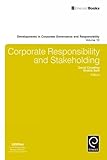Corporate responsibility and stakeholding / edited by David Crowther, Shahla Seifi.
Material type: TextSeries: Developments in corporate governance and responsibility ; volume 10.Publisher: Bingley : Emerald Group Publishing Limited, [2016]Copyright date: ©2016Edition: First editionDescription: 1 online resource (271 pages)Content type:
TextSeries: Developments in corporate governance and responsibility ; volume 10.Publisher: Bingley : Emerald Group Publishing Limited, [2016]Copyright date: ©2016Edition: First editionDescription: 1 online resource (271 pages)Content type: - text
- computer
- online resource
- 9781786356253
- 1786356252
- 9781786356260
- 1786356260
- 337
- HD60-60.5
| Item type | Home library | Collection | Call number | Materials specified | Status | Date due | Barcode | |
|---|---|---|---|---|---|---|---|---|
 Electronic-Books
Electronic-Books
|
OPJGU Sonepat- Campus | E-Books EBSCO | Available |
Print version record.
Front Cover; Corporate Responsibility and Stakeholding; Copyright Page; Contents; List of Contributors; Introduction: The Unknown Stakeholder; Introducing Stakeholders; Multiple Stakeholding; Wider Stakeholding and Its Implications; Stakeholder Perspectives on the Contract; Satisfying the Stakeholder Community; Knowing Our Stakeholders; Notes; References; Part I: Theorising Stakeholding; Hyper-Transparency: The Stakeholders Uprising; Introduction; Corporate Responsibility; Transparency; Trust; Stakeholder Paradigm; Hyper-Transparency; Drivers and Tools; Concluding Remarks; Notes; References.
The Role of Shapeholders as a Link between a Firm and Non-Stakeholders: The Pursuit of an Economy for the Common Good Based on Stakeholder TheoryIntroduction; Limits on the Conceptualisation of the Economy for the Common Good; Stakeholder Theory as the Realisation of the Economy for the Common Good; Overcoming the Limits of Stakeholder Theory in Relation to the Common Good; Incorporating Responsibility towards Non-Stakeholders; Mechanisms for Incorporating the Interests of Non-Stakeholders; Conclusions; Notes; Acknowledgements; References; Microfinance and Women Empowerment; Introduction.
Background to the ResearchStudying Microfinance; Quantitative versus Qualitative Research; Findings and Discussion; Focus Group Data Analysis; Conclusion; References; Managing with Depleted Resources; Sustainability in the Present; Global Warming; Resource Depletion; Sustainability and Sustainable Development; Renewable Energy; Energy Efficiency; Critiquing Sustainability; Access to Resources; Conclusions; Notes; References; Corporate Stakeholding and Globalism: A Need for Revision of the Stakeholder Concept Using the RESIST-Model against 'Business-as-Usual'; Introduction.
Stakeholder Theory, Models and ConceptsThe 'Butterfly Effect' and Its Implications on Stakeholder Theory; Corporate Scandals and Stakeholderism; A New Way to Perceive Global Stakeholderism; Notes; References; Part II: Stakeholding in Practice; Influences on Stakeholder Engagement in Sustainability Accounting and Reporting: A Study of Australian Local Councils; Introduction; Stakeholder Engagement in Sustainability Accounting and Reporting; New Institutional Theory; Research Methods; Influences on Stakeholder Engagement in Sustainability Accounting and Reporting; Coercive Influences.
Mimetic InfluencesNormative Influences; Internal Influences; Coercive Influences; Mimetic Influences; Normative Influences; Internal Influences; Coercive Influences; Mimetic Influences; Normative Influences; Internal Influences; Discussion; Conclusion; Notes; References; Determinants of Sustainability E-Reporting in Portuguese Municipalities: An Institutional and Legitimacy Theoretical Framework; Introduction; Theoretical Framework: Complementarity between Institutional Theory and Legitimacy Theory; Research Design; Research Hypotheses; Sample Characterisation; Methodology.
Model and Variable Design.
Although much consideration has been given to the relationship between a corporation and its stakeholders, less attention has been given as to who those stakeholders might consist of. Nevertheless in this globalised world the effects of the actions of a corporation can been seen to extend far beyond the boundaries of the organisation and far beyond the countries in which that corporation is domiciled or operates. Indeed not only can a butterfly flapping its wings cause a hurricane in another part of the world but also a minor decision by a corporation can have a dramatic social, economic or geopolitical impact in other parts of the world. Thus the stakeholder community of a corporation must be considered as far greater than its voluntary stakeholders, far greater than its internal stakeholders and far greater than its supply chain and value chain. This has considerable implications for the corporation and its approach to both its operations and its sense of corporate responsibility. Too often this is not considered or even recognised so in this book we take the widest definition of stakeholders and consider aspect of the corporation's responsibility to this community.
Includes bibliographical references.
eBooks on EBSCOhost EBSCO eBook Subscription Academic Collection - Worldwide
There are no comments on this title.

